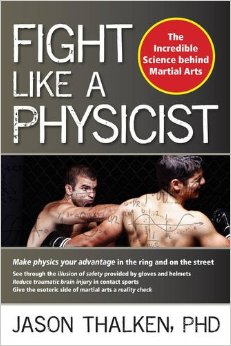
Fight Like a Physicist
December 02, 2015
“In order to get the most energy from your punch, speed is your primary goal”
Jason Thalken, Phd, Fight Like a Physicist
 I’ve started reading the hot new book in martial arts, Hapkido Black Belt and scientist Jason Thalken’s
Fight Like a Physicist: The Incredible Science Behind Martial Arts
.
I’ve started reading the hot new book in martial arts, Hapkido Black Belt and scientist Jason Thalken’s
Fight Like a Physicist: The Incredible Science Behind Martial Arts
.
Interestingly, he begins with a description of the early UFC and this idea that “if you’re so good, why aren’t you fighting in the UFC?”
He then implies that the early UFC was a valid scientific arena for testing fighting hypotheses (this style beats that style). I both agree and disagree with that idea, which has been viral on the internet ever since.
He even says that if you “want to know if a spinning hook kick is as deadly as your instructor says it is? …see if you can find anyone who has used it in a professional fight.” I’ve said it before and I’ll say it again. Fighting in the ring is inherently different than fighting on the street. The physics may be the same, but the environment, the psychology, the timing, and what works or doesn’t work is very very different.
Just ask that professional fighter who gets hit in the head with a board at the gas station brawl.
Or the kickboxer who gets cold-cocked by the friend of his opponent. Or anyone who gets sucker-punched by a crafty street fighter. This is is not the ring. Other skills are involved and need to be considered.
There is a great example of this in the film Dead Presidents — the young soldier discovers his wife has become a prostitute while he was in the war – when he confronts the pimp, the man first smiles and makes him relax, then he punches him out of the blue, knocking him down the stairs, as he pulls his gun. This is streetfighting. Here is a harsh clip of the scene (note: lots of profanity).
People who try to draw direct links from fighting in the ring to fighting in the streets always neglect these questions of the psychological transition from normal life to fighting. When aggression kicks off, the question in the mind is “how far are we going to go here?” The fighter who goes the furthest the fastest wins. The fighter who deceives often wins. None of this happens in the ring.
But all this aside, guys inherently want to know, is my style the “best?”
And the mental hardwiring we have as humans predisposes us to certain types of in-group/out-group blindnesses and rationalizations.
We hear arguments that support our preferences and biases and are deaf to opposing ideas and arguments. This is just the way we are built and the “scientific method” of double blind studies and repeatable experiments and peer review, etc, was largely developed to try to offset these self-serving ideas and help us to arrive at truth.
So I will agree that one element in the equation is the nuts and bolts of force delivery and this is where Thalken’s book is useful.
I’m only a few chapters in and so far, Thalken has been helpful by clearly spelling out certain physics ideas that apply to fighting.
We’ve all heard various explanations of momentum and force and velocity to describe the physics of punching.
This was one of the clearest explanations I’ve come across:
“a large 200-pound man jogging 5 mph (mph)(200*5=1000) and a petite 100-pound woman running 10 mph (100*10=1000) will each hit you with the same momentum and knock you back just as hard.”
This really makes you think about the role of speed in your strikes!
And another quote underlines this further:
“if you were to double the mass of your punch, you would double the energy, but if you doubled the velocity of your punch, you would end up with four times the energy”
And, of course, there is the idea that if you concentrate the energy into a smaller area, the damage is localized and more intense.
The knife is the most intense example of this, but in Wing Chun we use the four to one strike pattern to capitalize on this “point.”
I’ll likely have at least one more post on this book as I get further along.